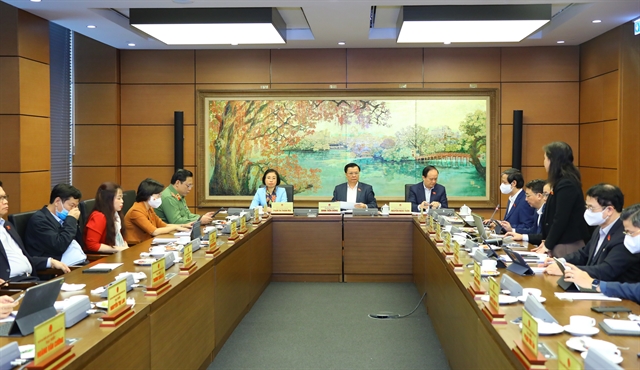 Politics & Law
Politics & Law


|
| National Assembly deputies of Hà Nội discuss a draft resolution on a number of specific mechanisms and policies for the development of four localities. — VNA/VNS Photo |
HÀ NỘI — Specific mechanisms and policies for Hải Phòng City, Nghệ An, Thanh Hóa and Thừa Thiên-Huế provinces aim to promote self-reliance and the potential of each locality, said Minister of Planning and Investment Nguyễn Chí Dũng.
The minister made the statement on Friday while delivering a report at the National Assembly (NA) session on a draft resolution on the development of the four localities.
He said the mechanisms and policies aimed to strengthen decentralisation, increase autonomy and self-responsibility of local authorities at all levels.
Six mechanisms have been proposed for Hải Phòng City, Thừa Thiên-Huế Province, Nghệ An Province and eight mechanisms have been proposed for Thanh Hóa Province.
According to the draft resolution, the annual additional funds for Thanh Hóa, Nghệ An and Thừa Thiên-Huế provinces from the central budget collection in each of the provinces would not exceed 70 per cent of the increase in revenue from import and export activities there.
The annual additional fund from the State budget for Hải Phòng City must not exceed 70 per cent of the increase in central budget revenue compared to the estimate assigned by the Prime Minister.
The draft resolution also stipulates a number of specific mechanisms on piloting a fee and charge policy in each locality, land and forest use management which will take effect from January 1, 2022, and will be implemented for five years.
Delivering a verification report on the draft resolution, chairman of the NA Finance and Budget Committee Nguyễn Phú Cường said the committee agreed with the five-year implementation of the resolution. The cap for additional funds will bring the localities’ potential into full play and boost development.
Discussing the draft resolution in groups, NA deputies agreed on the necessity to approve the resolution to legalise the Politburo’s resolutions on creating mechanisms to mobilise resources and promote local socio-economic development.
The deputies spoke highly of breakthrough policies and specific mechanisms which aim to foster the growth of not only one locality but the whole region.
Deputy Vũ Xuân Hùng from Thanh Hóa Province said the province has an important geographical position and a number of advantages.
Thanh Hóa now has eight industrial parks, attracting nearly 2.5 million workers, especially Nghi Sơn Industrial Park. "There are a lot of key projects in the province so investment in development is an urgent requirement," he said.
Deputy Phan Viết Lượng from Bình Phước Province said Thanh Hóa and Nghệ An were two provinces with a large population and area with dynamic economic development but both provinces still face difficulties in infrastructure.
He pointed out that due to traffic difficulties, it is faster to travel from the centre of Nghệ An and Thanh Hóa to Hà Nội than to the remote areas of these two provinces. This problem needed to be quickly solved by a specific policy mechanism.
Deputy Nguyễn Trường Giang from Đắk Nông Province said the resolution focused on financial mechanisms but did not mention organisational structure and investment.
He proposed the Government continue to study this.
NA Chairman Vương Đình Huệ said Việt Nam’s policy institutions were unified, but in the process of development, it was necessary to pilot a number of new mechanisms and policies. If the pilot results were effective, the policies would be replicated nationwide, raising policies and laws to a new standard.
Piloting mechanisms in some localities also aimed at a common goal of national governance, he said.
The mechanisms and policies submitted by the Government to the NA have been carefully prepared by localities and Government agencies, and verified and reviewed by NA agencies. The NA Standing Committee gave feedback and submitted them to the NA for further approval. — VNS




